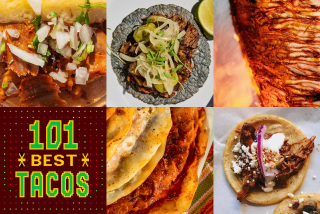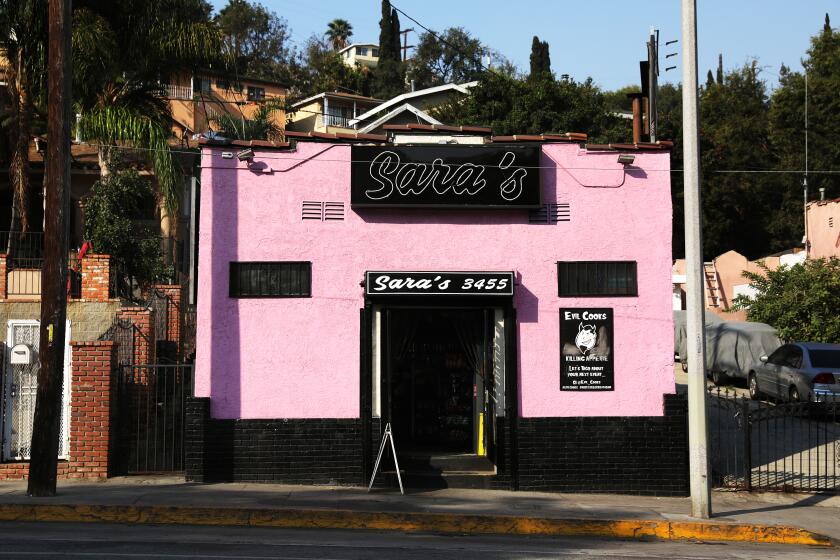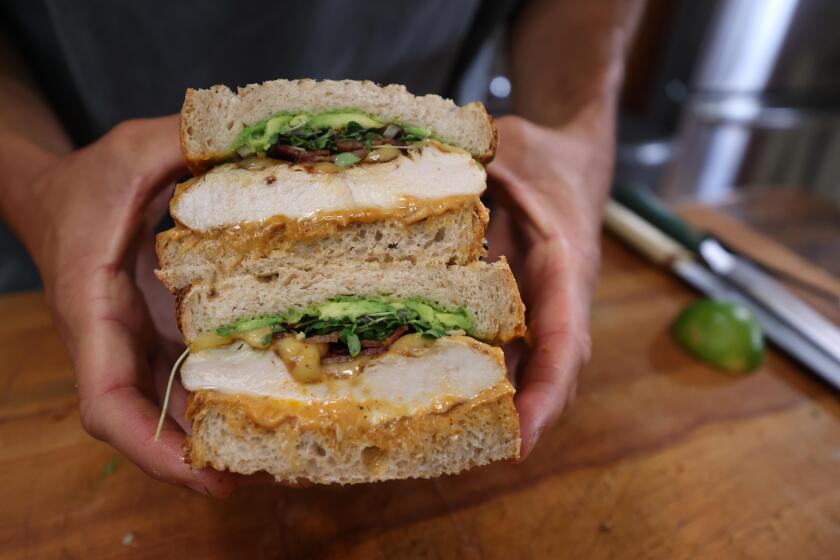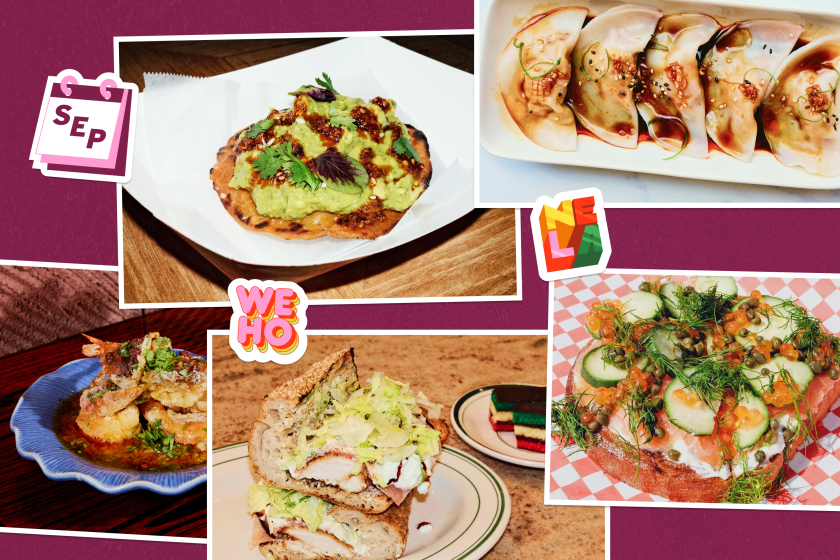A Little <i> Xampany</i> Is Good Company in Barcelona : Spain’s Olympic city bubbles over with friendly bars that specialize in sparkling wine.
What do Sherlock Holmes, Blackcelona, One Way, Touchdown, Yuppies, La Gasolinera, No, Rothko, Unbar, West Coast, Zsa Zsa, Clandestino, Beat, Nick Havanna, Falstaff, Hop, Fin/Al, New Sausalito, Popeye, Speed, Status, Sucesso, Crisis, Karma, The End, Lips, Trip-Tic, Dry Martini, Sidecar, The Daily Telegraph, Let’s Go, Hollywood, Paris, Maryland, Zurich, Soweto and Ping Pong have in common? They’re all names of bars in Barcelona. There are also bars called El Sot (which actually means “the pit” or “the grave” in Catalan), Basinger (whose advertisements feature full-maned, pouty-lipped Kim Basinger look-alikes) and, maybe best of all, Drinking in the Rain--among hundreds of others.
Barcelona is, to put it bluntly, a great bar town, full of drinking places of every kind, from dingy workmen’s dives to glitzy discos, from Andalusian-inspired tapas bars to English-inspired pseudo-pubs, from clubby old-style cocktail emporiums (where, incidentally, the art of intricate cocktail-making thrives as it hasn’t for decades in America) to so-called “design bars”--which feature pricey drinks, a chic clientele, loud music and drop-dead hip interiors created by such well-known local architects and designers as Javier Mariscal (also responsible for the ’92 Summer Olympics mascot, Cobi), Alfred Arribas, Eduard Samso and Toni Riera.
Perhaps the one essential Barcelona bar is Boadas, a minuscule triangular-shaped establishment just off the Ramblas, opened in 1933 by a famous high-society bartender from Cuba, whose daughter is still in charge. The walls are crowded with memorabilia from Havana’s Golden Age, the room itself is always jam-packed with stylish-looking locals, and cocktails of every sort are prepared here with great old-fashioned flair. (The bartenders love to show off, mixing their potations by pouring them back and forth through the air in perfect arcs from one shaker to another--really something to see.)
Three other great bars in the city are Ideal Scotch, vintage 1931, offering a remarkable array of single-malt Scotch whiskeys, as well as an encyclopedic catalogue of cocktails (and, incidentally, a fine cigar selection), in warm and comfortable surroundings; Dos Torres, a good-looking, easy-going, contemporary-flavored place in a nicely redone turn-of-the-century mansion, with a delightful terrace (with its own bar) in summertime and a standard cocktail repertoire; and what might well be the ultimate design bar, Torres de Avila, in the Poble Espanyol or Spanish Village on Montjuic--an immense, multilevel Arribas- and Mariscal-designed fantasy land with an astronomical/astrological theme, complete with an electric moon and sun which move across the walls in synchronization with a computerized soundtrack that ranges from Yma Sumac to Steve Reich to Ry Cooder.
But best of all, and most typical of Barcelona, is the genre of meeting-and-drinking places known as xampanyerias. These, not surprisingly, are places that specialize in xampany --and to figure out what that is, it is necessary to know only that the “x” in Catalan represents a “ch” sound while the “ny” is pronounced approximately as the French would pronounce “gne”. Xampany thus equals Champagne--though most of what’s served isn’t really true Champagne from France, at all.
This requires a bit of explanation: For more than a hundred years, winemakers in the Penedes region, west of Barcelona, have been producing sparkling wines using Champagne-style technology but mostly local grape varieties (specifically the ones called macabeu, parellada and xarel-lo). These wines were usually labeled as “champana,” the Castilian Spanish rendering of Champagne. (They weren’t called xampany simply because the public use of Catalan was banned under Franco.)
In 1960, however, the French Champagne industry decided to challenge Spain’s use of the term, and brought suit against one prominent Spanish champana producer in a British court--Great Britain having been the major export market for such wines at the time. The French won, and in the resulting settlement, Spanish sparkling wine producers as a whole agreed to stop calling their wines champana.
Seeking a new term to describe the wines, the Spanish came up with cava, which simply means cave or cellar, and this term has endured. (Since the early 1970s, cavas have become extremely popular in America--Codorniu and Freixenet, pronounced approximately “fresh-uh-net,” are the major brands and indeed, between them, account for probably 90% of the cava produced--and they are almost always good values, and almost always crisp and delicious.)
The word xampany, in fact, is rarely used--but when the first bar in Barcelona devoted to Spanish sparkling wines opened in 1981, it called itself La Xampanyeria (perhaps to tweak the French?), thus both coining a term and starting a fad. Today, there are at least 15 xampanyerias in the city, and they may also now be found in most other Catalan cities of any size. There are even a few xampanyerias in Madrid and elsewhere in Spain.
La Xampanyeria is a bright, white-walled, breezy sort of place in the middle of the area known as the Eixample (or “Expansion”)--the grid-like pattern of streets into which Barcelona grew in the late 19th and early 20th centuries.
The decor is contemporary but not aggressively so, with simple metal cafe chairs and tables scattered around the room, some so-so art on the walls and an open-sided staircase leading to a mezzanine level.
The clientele tends to be young and cool, but not exactly avant-garde. At least 50 different cavas are served, including not just a full range of sparklers from Codorniu and Freixenet and their subsidiary labels but also wines from such excellent smaller cava houses as Marques de Monistrol, Cavas Hill, Juve & Camps, Nadal, Gramona, Torello (owned by the family of International Olympics Committee president, and Barcelonan, Juan Antonio Samaranch, incidentally), Llopart and Mascaro. As is typical in xampanyerias, a different cava label is featured everyday, with wines by the glass served at nominal prices (usually around $3-$5). There are also a few French Champagnes, and, as is typical at xampanyerias, a small selection of upscale snacks--caviar, mountain ham, elaborate ice cream concoctions, etc.
Another top xampanyeria is Xampu Xampany (“Shampoo Champagne”), on the busy Gran Via. Here the tables are marble-topped, the surroundings are more demonstratively post-modern (in the pediments-and-columns genre) and there is a noticeable soundtrack, fading from Ellington to INXS to assorted European techno-pop ensembles and back. The cava selection is similar to that at La Xampanyeria, but prices are slightly lower, and little squares of toast spread with homemade pate are offered with the wine of the day.
The most eccentric of the city’s xampanyerias, and perhaps the most enjoyable, is El Cava del Palau--the “palau” or palace in question being Domenech i Montaner’s extravagantly detailed Palau de la Musica Catalana, a Gaudi-era concert hall that is one of Barcelona’s most remarkable turn-of-the-century buildings. El Cava del Palau, which is about a block away, down a narrow street that begins almost in front of the concert hall, seems small when you enter, until you realize that there are four open levels, each one packed with bistro-style tables.
In one corner, upstairs, there is a pianist, playing jazz and show tunes. On many of the tables sits a goldfish bowl, with live goldfish included. The waiters are chatty and funny. The list of cavas and French Champagnes is extensive, and they are impeccably served. The anchovies and duck-breast ham are some of the best in town (if eating anchovies under the eyes of goldfish doesn’t bother you). And if you walk into the place late enough--after midnight is best--you’ll think there’s a party going on, full of merriment and good spirits. And you’ll feel, with reason, that you’ve been invited.
GUIDEBOOK
Champagne Dreams
When to go: Xampanyerias are open from 6 or 7 p.m. until 2 or 3 a.m. Because they serve sparkling wine by the glass and offer hors d’oeuvres-style food, they are good places to stop for an aperitif before dinner (especially since you’ll rarely eat dinner before 10 p.m. in Barcelona). For some reason, though, locals rarely use xampanyerias for this purpose, reserving them almost exclusively for after-dinner drinks (and eats). Prime time in these establishments, then, is generally about midnight to 2 a.m. At 2, it’s time to hit the discos.
Where to go: La Cava del Palau, Verdaguer i Callis, 10 (near the Gothic Quarter), closed Sundays; about $3-5 per glass.
Xampu Xampany, Gran Via de les Corts Catalanes, 702, open daily; about $3-5 per glass.
La Xampanyeria, Baron Provenca, 236 (at Enric Granados), closed Sundays; about $3-5 per glass.
Other recommended xampanyerias: Artcava Fussina, Fussina, 6; Casablanca, Bonavista, 6; La Folie, Bailen, 169; La Cava de Olimpia, Loreto, 10; La Pergola, Reina Cristina (near the Port).
Recommended bars: Boadas, Tallers, 1 (near the Rambles); Dos Torres, Via Augusta, 300; Ideal Scotch (also called Ideal Cocktail Bar), Aribau, 89; Torres de Avila, Poble Espanyol, Montjuic.
More to Read
Eat your way across L.A.
Get our weekly Tasting Notes newsletter for reviews, news and more.
You may occasionally receive promotional content from the Los Angeles Times.










